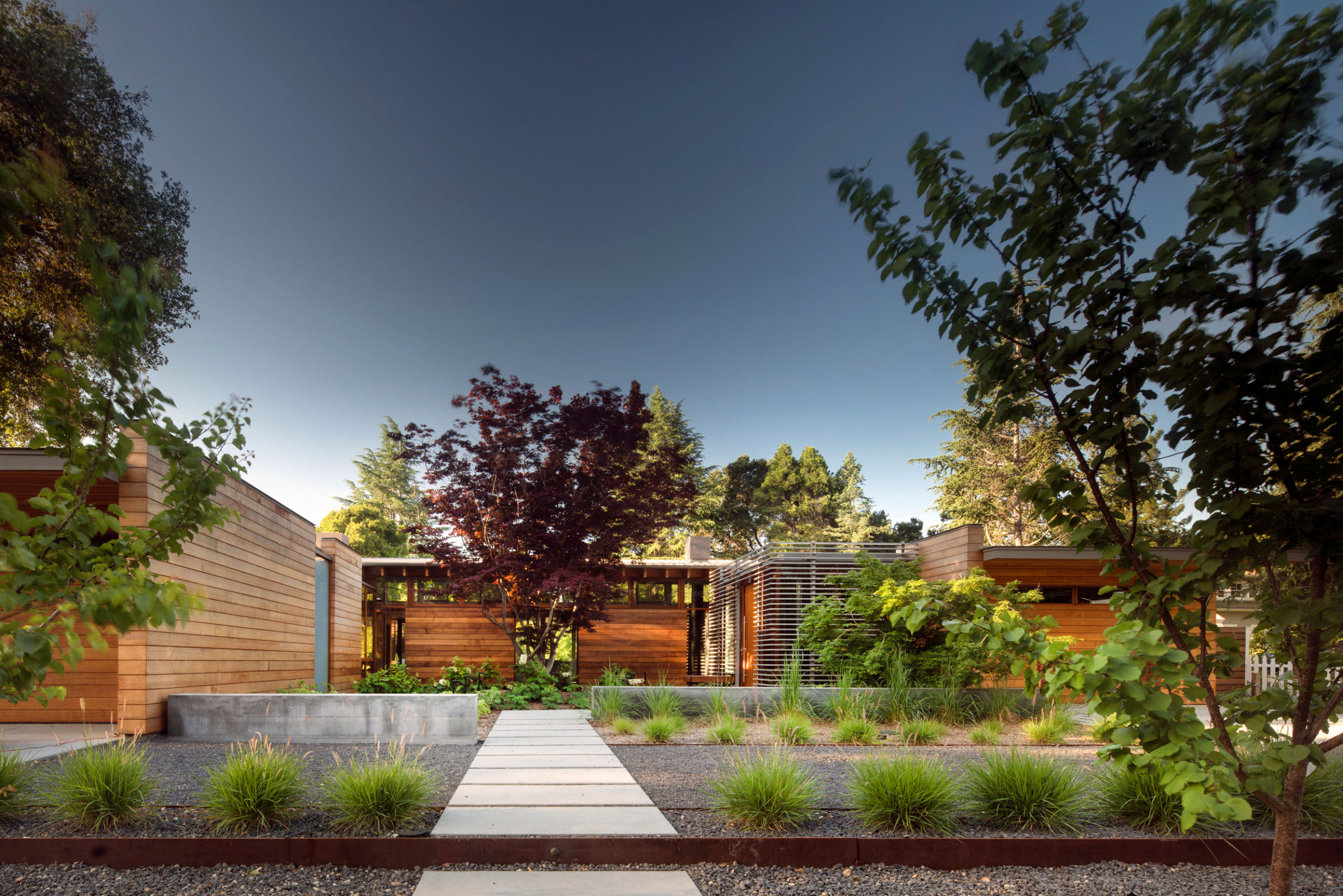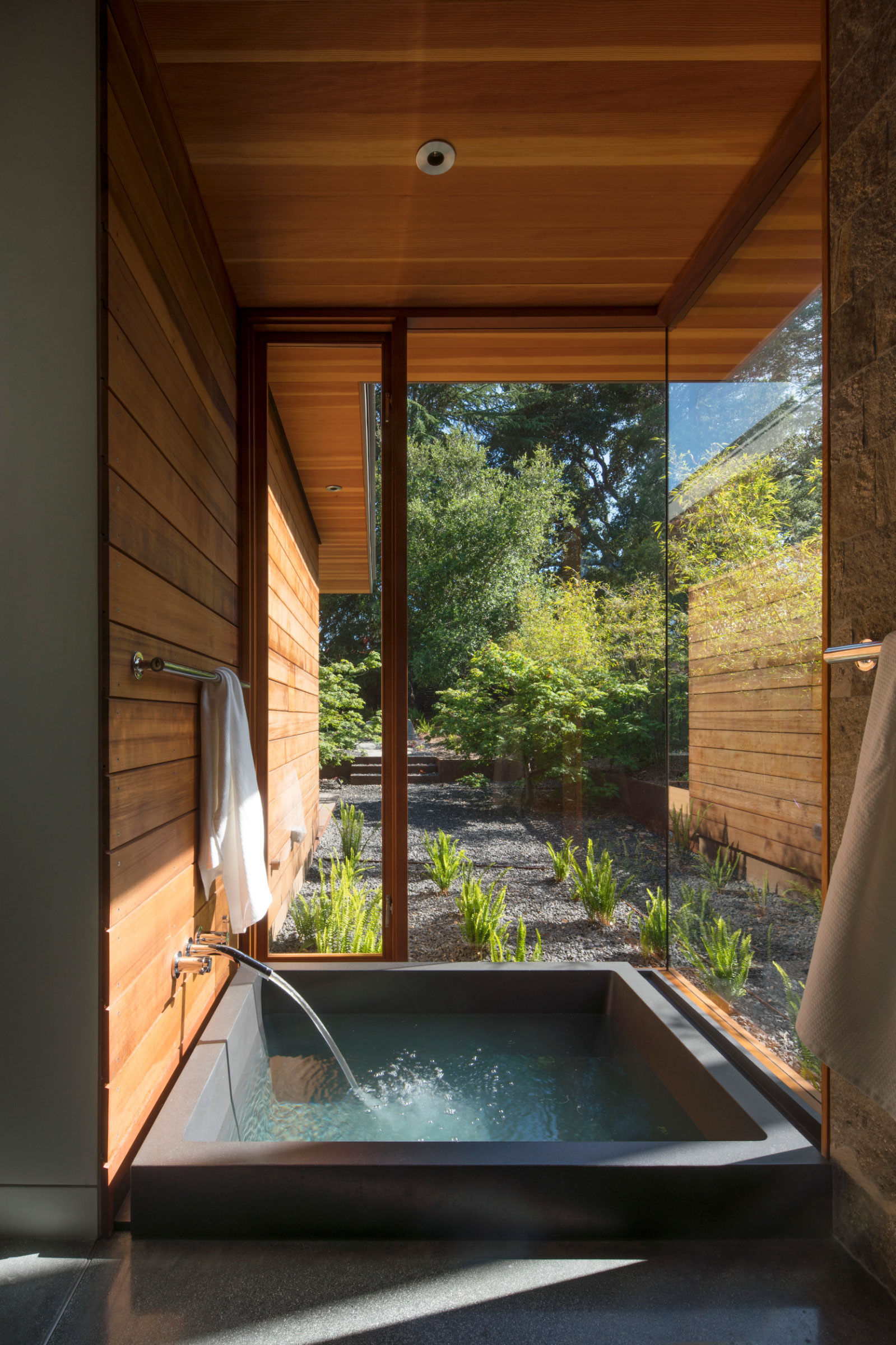Story at a glance:
- Architects say western red cedar spaces makes for beautiful, sustainable projects.
- A Los Altos project, designed by Bohlin Cywinski Jackson, used entirely FSC-certified cedar.
- Cedar siding used throughout the renovated portions of a Napa Valley project accentuates the traditional gray-painted cedar shake of the former design.
A modernist reinterpretation of northern California ranch style, a farmhouse in wine country, student residences at Frank Lloyd Wright’s renowned Fallingwater—these and many Bohlin Cywinski Jackson (BCJ) residential projects are dominated by western red cedar (WRC).
“We use cedar a lot in our residential projects in particular,” says Greg Mottola, BCJ’s lead principal on both a Los Altos modern ranch project and a beautiful farmhouse in Calistoga. “We like cedar because it brings a warmth, a softness to what are otherwise pretty modern buildings, and we like making these homes more livable and comfortable to be in.”
In Los Altos, BCJ was tasked with reinventing a home on the suburban site of a teardown. The clients wanted a house that felt like a natural escape in an urban area—and they wanted it to be net zero energy. “We had the opportunity to really start from scratch. How do you make something that is modern and help them live the way they wanted to live—in a contemporary world—but also bring this Northern California modern sensibility to the design?” The answer was, in part, by using WRC.
The architects put their twist on what they consider the classic mid-century modern architecture of the region and came up with a design to meet the clients’ desire for privacy, beauty, and sustainability. Western red cedar, they said, was a no-brainer. “It’s warm and inviting.”
We talked to BCJ and other experts about why they design western red cedar spaces for beautiful outdoor escapes.
Rot-resistance
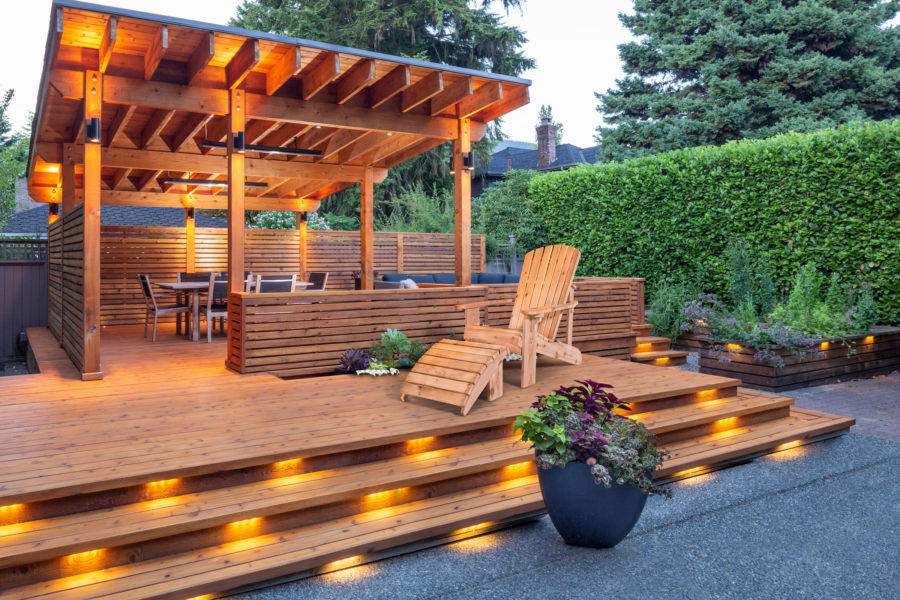
This project in British Columbia also uses Western Red Cedar. Photo courtesy of Western Red Cedar
Mottola says using WRC outdoors is helpful because it’s not just beautiful; it’s naturally rot-resistant.
The scientific name for western red cedar is Thuja plicata, says Erik Ostensen, director of marketing and product management for Western Forest Products, which began its operations in 2004 on the coast of British Columbia and now has operations there and in Washington State. WRC has one of the widest spread growth ranges on the West Coast and is often found growing alongside Douglas-fir and western hemlock. The name Thuja plicata comes from thujaplicin—a chemical substance found in mature trees that serves as a natural fungicide, preventing the wood from rotting, Ostensen says.
WRC can be finished in a variety of ways, and you can add pigment if you want, which Mottola loves. “In some ways it’s almost like you’re pre-weathering it. But the other thing we really love about it is that when you leave it to weather naturally, it turns to a beautiful silver color.”
Hardiness
Ostensen says the species’ growth rates are likely to thrive as accelerated climate change occurs. Reports from the US Forest Service indicate that it tolerates shade very well, too, and is less susceptible to diseases than many other conifers. The trees can live for more than 1,000 years.
Lightweight & Versatile
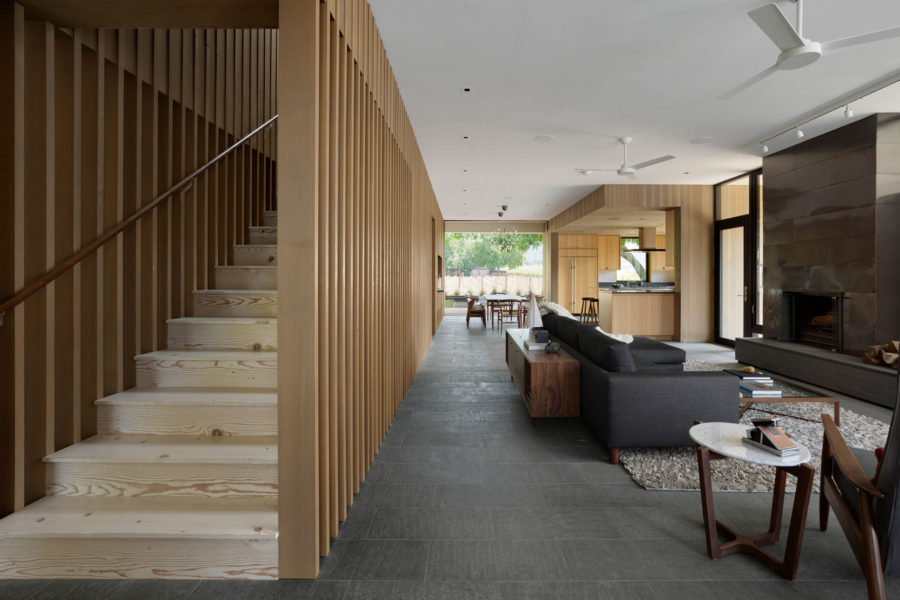
A cedar-clad spine guides the view through this Wine Country farmhouse’s communal spaces to the vineyards beyond. Photo by Matthew Millman
WRC’s large, open cell structure makes the wood less dense than most other softwoods, so it’s also easier to move from place to place on the job. The versatility of WRC is one of the primary reasons it has been used for appearance and outdoor living applications for centuries.
Acoustics
Its open cell structure also helps to block noise. As an interior paneling or exterior siding, WRC’s low density makes it an acoustical barrier of much greater quality than many products marketed for those applications.
Sustainability
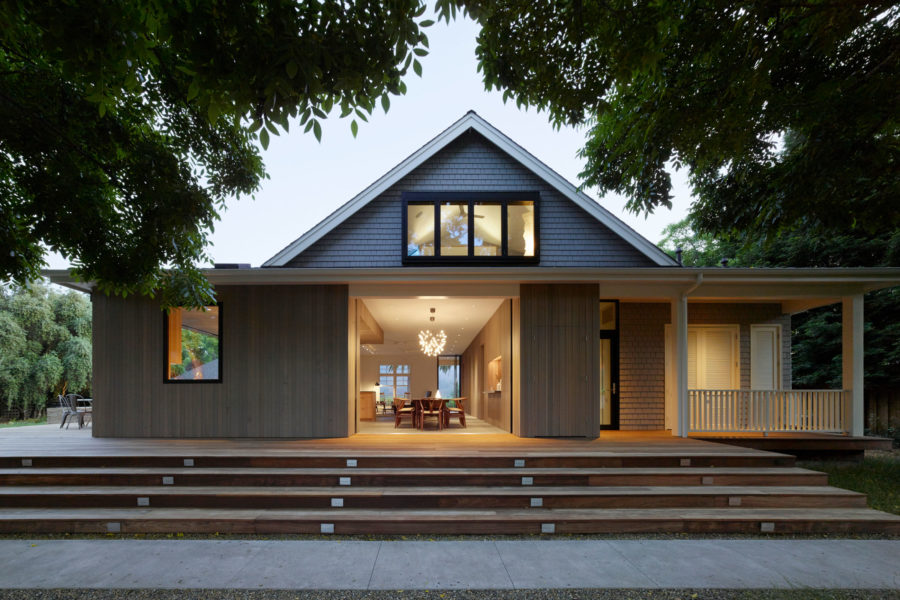
Cedar siding used throughout the renovated portions of the project defines the interventions and accentuates the traditional gray-painted cedar shake of the former design. Photo by Matthew Millman
The sustainability benefits of using WRC are many, whether it’s the durability of siding or environmental impact of decking. WRC decking had the least environmental impact when compared with both virgin and recycled wood-plastic composite decking products, Ostensen says.
WRC siding performed best overall in comparison with vinyl, fiber cement, and brick. It can also help architects earn LEED points in the area of Materials and Resources credits.
Of course, wood is also the only major building material that’s renewable. “There are more trees now in North America than 100 years ago due to diligent forestry practices,” Ostensen says. Western red cedar comes from the most sustainably managed forests in the world.
Biophilia
- A series of tall cedar-clad walls slip between interior and exterior, anchoring the spaces with the outdoors. Photo by Nic Lehoux
- Cedar siding along the western edge of the residence extends inside the house. Photo by Nic Lehoux
The architecture firm works on projects all over North America and aims to bring a bit of the outside in across residential designs. Mottola says they’re pleased with the quality of cedar they get for projects like these, as it makes their jobs easier.
Inside the Los Altos residence, walls are cedar, juxtaposing beautifully against the polished concrete floors. The architects chose WRC specifically to provide a sense of warmth in contrast to the exposed structural steel, polished concrete floors, and textured concrete fireplace. In Calistoga, the cedar-clad kitchen volume opens onto an outdoor porch and dining area overlooking the pool and renovated water tower.
“One of the things that’s great about using cedar is that it also helps you develop a human-focused scale to the building,” Mottola says. “It’s very relatable. It doesn’t feel overwhelming at all. In fact it feels quite comfortable. We wrap that material both inside and out. This whole idea of buildings that blur the line between inside and outside really enhances the idea of outdoor living.”
Color
But there’s also something special about WRC’s color. BCJ loves it so much they use it inside and out on their residential projects.
“It’s just really versatile,” Mottola says. Because of its rich color and the fact that it takes stain really well, Mottola says it’s a great solution for exterior siding.
WRC is pitch- and resin-free, so it will accept and hold a wide range of finishes—including elegant dark stains, shabby chic bleaches, traditional solid colors, and naturally beautiful semi-transparents, Ostensen says.
At Los Altos, a series of tall cedar-clad walls slip between interior and exterior, anchoring the spaces with the outdoors—including all around the master bathroom and its luxurious Japanese soaking tub. “The line of exterior siding runs right inside, so when you’re in that bathtub you’re kind of perched on the edge of the building looking out to the garden. You feel like you’re connected to the landscape,” Mottola says.
BCJ also used WRC around the entire perimeter of the project. “Fencing is another pretty common place where we use it,” Mottola says. There they put a dark, almost brownish gray stain on the cedar.
Style
WRC bevel siding is the most widely used cedar siding type across projects. It is produced by resawing lumber at an angle to produce two pieces thicker on one edge than the other. The manufacturing process results in pieces with one smooth face. The other face is saw textured or smooth depending on the grade and customer preference.
Bevel siding is installed horizontally and gives an attractive shadow line that varies with the thickness of siding chosen. You can get bevel siding in clear or knotty grades. Clear siding gives a premium quality appearance ideal for prestigious, upmarket applications, while knotty grades come with a re-sawn face and incased tight knot characteristics that can’t be imitated, Ostensen says.
Other projects may choose knotty channel siding for its warmth and casual charm that translates well on homes, cottages, clubhouses, and anywhere you want a rustic feel.
Durability
Mottola says BCJ comes back to WRC again and again for its durability. Western red cedar heartwood is also highly impermeable to water, making it even more durable.
While WRC is prevalent on BCJ’s West Coast projects, Mottola says they are seeing it used more all over the US, including the East Coast, too. “We do projects all over the country and a lot of second homes for people in beautiful, remote locations. Cedar is a nice choice.”
Like all woods, WRC will absorb or discharge moisture to attain equilibrium with the surrounding atmosphere. However, it has a very low shrinkage factor and is superior to all other coniferous woods in its resistance to warping and twisting.
Ostensen says historically native peoples of the Pacific Coast loved cedar for its long-lasting qualities and used wood and bark from cedar trees to build their structures. You can still see many of those cedar artifacts in good condition today, he says. Properly finished and maintained, cedar will deliver decades of worry-free service.
Insulation
Using WRC can also minimize heating and cooling needs. Wood has very good insulating value compared to other materials. Lab tests at the National Research Council of Canada and the Oak Ridge National Laboratory show that light metal framing significantly reduces the effective thermal resistance, or R-value, of a wall assembly, resulting in increased energy use. Wood-frame construction is easy to insulate to high standards, Ostensen says, and several wood-frame assemblies have been designed for the Arctic.
WRC’s low density increases a home’s insulation by transporting less heat through interior wall paneling or exterior wall siding than brick or stone, vinyl, or gypsum drywall. It also helps keep interiors warmer in cold weather.

